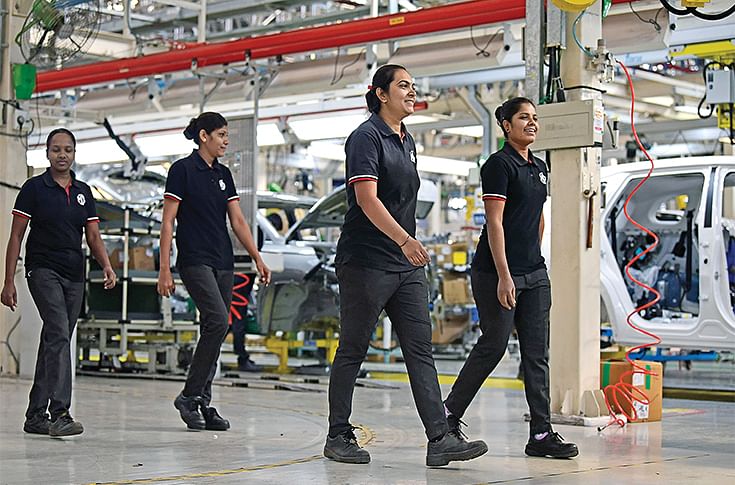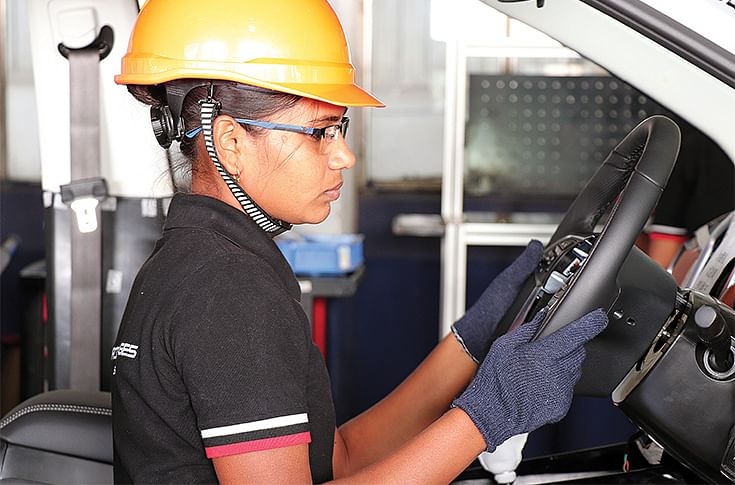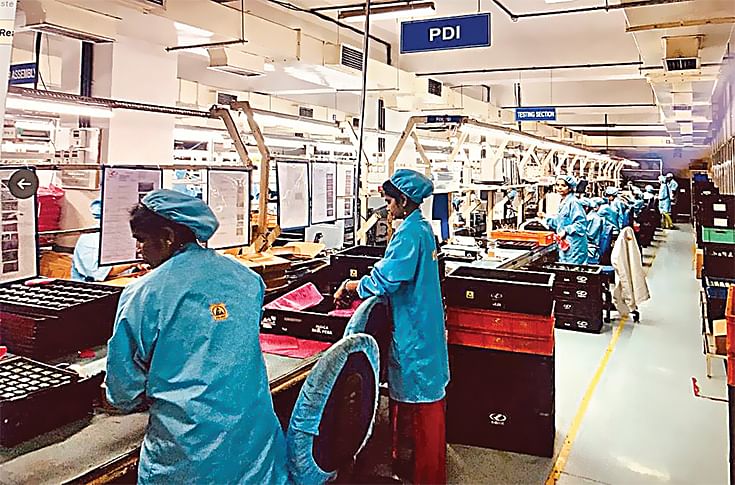The unequal balance
The pandemic highlighted the inequalities across workplaces and how social conditioning continues to be a major roadblock for women keen on success professionally.
“In the 19th century, the central moral challenge was slavery. In the 20th century, it was the battle against totalitarianism. We believe that in this century the paramount moral challenge will be the struggle for gender equality around the world,” said American journalist and two Pulitzer Prize winner, Nicholas D Kristof. Nowhere else is this inequality as striking as the plight of women in a Covid-scarred world.
We often hear that Covid-19 had led to many drastic changes in our lives but probably the heaviest toll has been on women. Juggling expanded duties at home with their careers, managing kids, their online schools coupled with the unique social conditioning has led to a severe impact on the work-life balance for women. As the UN Women report on the Covid-19 impact highlights, “The impacts of crises are never gender-neutral, and Covid-19 is no exception.” According to the UN report, this pandemic will worsen the gender-poverty gaps and nearly 232 million women are expected to be in the poverty zone by 2030 compared to 221 million men. The latest McKinsey report indicates that women make up 39 percent of global employment but account for almost 54 percent of job losses. Meanwhile a Deloitte study shows that almost seven out of every 10 women expect a negative shift in their career progression. Over 60 percent have more responsibility of household chores and women with caregiving responsibilities has tripled. According to their calculation, global GDP growth could be almost $1 trillion lower in 2030 compared to a situation where women’s unemployment was at par with men. It goes without saying that under representation of women does not augur well with economic development either. As Harshbeena Zaveri, Vice-Chairman and Managing Director, NRB Bearings puts it, “I think that patriarchy shines brightest in this Covid situation and equality between gender really takes a backseat.”
Patriarchy plays spoil sport
One industry where patriarchy comes through even in this day and era of increased initiatives for making the workplace more inclusive is no doubt the automotive sector.

Many industry observers believe that the barriers are breaking, and you increasingly see a greater number of women taking up leadership roles across departments.
Automobiles are traditionally considered a man’s bastion. Just like the car is thought to be strictly boy’s toys, working in a car factory was often thought to be out of bounds for women. Abha Gupta, Head – HR , Bike Bazaar, recollects the problems that women faced just two decades ago, in even the leading automotive factories, where there weren’t adequate restrooms for women and they had to “walk across the plant if they had to and as a result plan the entire day around that. Surely, we have come a long way from that position to the present having an all-women assembly line.”
Well, that’s only one side of the coin. While news headlines celebrating all-women assembly lines or talking about recruiting more women surely brings in a concept of what many can consider a level-playing field for all, the concern is that despite these steps neither the attitude has changed nor has the inequality lessened. Probably that’s the reason that the number of women who are employed has greatly gone down in the last 10-12 years. As Zaveri points out, “India, per se, has not done well at all in gender diversity. And we all know that our ranking in the gender kind of parity index is very, very low.” In fact, the rate of participation of women in the workforce across India is a pitiful 20 percent compared to many high-income countries with participation rate is north of 50 percent.
A detailed chat with many women leaders in the industry reveal that probably this also is due to nature of the industry. “One of the key reasons that the automotive industry, traditionally had more men participating is also because of the mechanical nature of the job,” says Sulajja Firodia Motwani, founder and CEO of Kinetic Green Energy & Power Solutions. Manufacturing traditionally has been a rather conservative industry and in the Indian context that’s also made it male dominated. As Zaveri mentions, it is therefore “considered difficult environment from a patriarchal point of view,” highlighting the cultural conditioning and its long-term impact.
Policy problems
The question then is how do we deal with this inequality? Can policies and legislation help fix the situation? According to Zaveri, “It is complex, because a lot of the policy initiatives also have actually worked against women, for example, longer maternity leave.” She goes on to explain how by extending the maternity leave, the onus has indirectly fallen on the woman to bring up the child. Earlier, as a result of the shorter span of maternity leave, the family of the working women rallied around to chip in. However, “now that you've given a longer maternity leave, women can hold jobs, but they cannot have a career.” After all, who will promote a person who has been missing from action for over six months? There is no doubt a practical and professional angle to it.

Gupta too agrees that it is a complex challenge, “You have kids to raise, you have a family to work for and at the same time there is office and huge competition again. Juggling all of this is not easy.” She is confident that now “with better balance coming in, I think we will definitely shine.” The question that is worth debating is how exactly are we striving to create a balance? For her organisation, Gupta is focussing on creating a “conducive environment, motivate women to come back to office and support them to keep contributing.” As a result, they “started the concept of half-day, half-pay.”
She explains how the government-mandated six months' maternity leave may not be enough in certain cases, especially for nuclear families with very little help around. In that situation with this option, they are able to “slowly get back to work. We also give them option of work from home. We try to ensure that they are not away from mainstream for too long.”
Yeshwinder, Head of HR at MG Motor India, too highlights how increasingly companies are
“trying to make our workplace policies in the manufacturing units sensitive to the diverse requirements across genders.”
Zaveri, however, reiterates the need of the hour is a “change in society. The discriminatory mindset is the problem,” more than policies. “The legislation is done by very patriarchal men. If you see the recent spate of legislation, it is in fact harming women. Legislation that does not let women work 24 hours, legislation that treats women as someone else’s property, long maternity leaves where a legislation indicates that it is the duty of the mother to take care of the child.”
Lack of leadership

In many ways this leads to another glaring aspect of the inequality and the deep need for diversity. The patriarchal perception in policy making stems from the dearth of women in the actual decision-making position. While you do see plenty of employment opportunities for women in the junior or mid-management levels, there aren’t that many names that come up in the top rung leadership.
Mahua Acharya, MD and CEO of Convergence Energy Services (CESL), concurs with the thought that “demographics are not changing fast enough at the top. Many companies have women on the shopfloor — that development is both significant and welcome. But at the management levels, it is not fast enough.”
As Zaveri points out, “Presence of women at the decision-making tables — the Board is important. If at least three of the 10 aren’t women, it is mere lip service. HR does not count here, it only showcases a stereotype. I would rather see women heading the legal department or as a CXO. HR is a traditional women position. I would rather hire a man here. It is also about making a point and seeing it through.” Acharya also agrees, “Perhaps, not enough effort is made to recruit at the top — it takes policies, sensitivity, inclusiveness and a conviction to achieve diversity.”
Yeshwinder explains the situation from the HR perspective and highlights that “most of the people who have joined in the past 4-5 years are still in mid-management level. It is a cycle and 10 years down the line it will look more even.”
Motwani too believes that as “the barriers are breaking, you see increasingly a greater number of women taking up leadership roles across departments and that also boosts their confidence.”
Winds of change
In many ways, the EV transition is also seen as a vehicle of change. “Just like EVs are a disruptive force in the automotive industry, it is also leading to a certain disruption across the workplace demographics – a welcome change with more women participating. This is also playing a key role in making workplaces more inclusive and opening up opportunities for creating a more gender-neutral working environment,” says Motwani as she talked about changing trends .
Electrification is no doubt one of the biggest trends in the automobile world and it’s no doubt heartening to see a much broader participation by women in this space, especially in the leadership roles. Acharya looks at it as a perfect channel to bring about better diversity, “EVs is a new business and new emerging market. This is a good time to do things differently — and diversity is one of those things we can do well on.”
But is that sufficient for bringing about a demographic change? Zaveri passionately calls for change in society for any significant long-term change, “I want to change the men, I want to change the world I want to change the family structure, change the mothers, absolutely — the social conditioning.”
She explains how women are traditionally rewarded for achievement while men get promoted based on potential. Most times women “don't naturally demand higher visibility or higher stake at work, so they never get tested for leadership capability.” Given the social conditioning most times when they see that something is difficult and team is facing challenges, “the women say give this to me, I'm gonna do it. They also don't showcase their achievements adequately. They underplay them.” That is why she emphasises that “companies should have leadership programs for women early in their career where they are given the skills and coaching required to build those capabilities and showcase them effectively.”
Need for changemakers
Change does not happen overnight. Motwani sees the need for “the HR policies need to be flexible to accommodate some of the unique challenges that women face.” Even Yeshwinder agrees that “changes are underway to make the workplace more inclusive.”

Often the solution to a problem is identifying the right metrics. Even as businesses increasingly understand the need for diversity in their workforce, the inequalities persist because of a non-inclusive work environment. It could be social conditioning, conservative approach or lack of resources or understanding.
Perhaps it is the belief in this capability that makes the majority of women optimistic about their potential to progress in their careers despite the challenges created by the pandemic, notwithstanding the barriers. As Gupta says, “I think we have a much brighter future for women.” If acceptance of a problem is the first step to resolution, indeed there are many reasons to be hopeful.
RELATED ARTICLES
Renault in India: From Survival To Global Springboard
With complete control of its Chennai plant, a multi-fuel playbook, and bold export ambitions, Renault aims to reshape it...
EVs Gain Rapid Acceptance among India's Affluent Class
As India’s wealthy embrace electric vehicles with speed and style, the mainstream consumer weighs every step carefully.
Oben Electric: Swimming Against the Current
Even as the going starts to get tough for the smaller electric two-wheeler makers in the country, EV startup Oben Electr...





 07 Mar 2022
07 Mar 2022
 4073 Views
4073 Views





 Ketan Thakkar
Ketan Thakkar



 Yukta Mudgal
Yukta Mudgal

